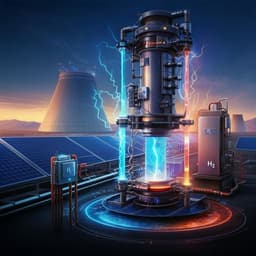
Engineering and Technology
Kilowatt-scale solar hydrogen production system using a concentrated integrated photoelectrochemical device
I. Holmes-gentle, S. Tembhurne, et al.
This groundbreaking research by Isaac Holmes-Gentle, Saurabh Tembhurne, Clemens Suter, and Sophia Haussener reveals a kW-scale pilot plant that efficiently co-generates hydrogen and heat using concentrated solar energy, achieving over 20% solar-to-hydrogen efficiency at a production rate exceeding 2.0 kW. Discover the technological challenges and future prospects of this innovative technology.
~3 min • Beginner • English
Introduction
The study addresses the gap between high-efficiency laboratory photoelectrochemical and integrated PV–electrolyser devices and their limited on-sun demonstrations at meaningful power levels. It aims to demonstrate and analyze a kilowatt-scale, thermally integrated solar hydrogen system using concentrated sunlight that co-generates hydrogen and heat. The context emphasizes the challenges of scaling solar-fuel systems—maintaining high efficiency, production rate, stability, cost-effectiveness, and sustainability—while highlighting solar concentration as a promising approach to boost power density, allow use of high-performance III–V absorbers, improve efficiency via thermal integration, and deliver useful heat. The purpose is to prove feasibility, quantify performance, identify dominant losses, and develop control and optimization strategies for real-world operation.
Literature Review
Prior work on solar fuels includes integrated PV+electrolyser systems, PEC cells, particulate photocatalysis, and thermochemical cycles, with most demonstrations <100 W. Thermally integrated, concentrated PV–EC architectures have shown synergistic benefits: PV cooling reduces recombination while elevated reactant/catalyst temperatures lower overpotentials and membrane resistance, improving electrolyser performance and enabling co-generation of heat. Previous integrated devices reported STH efficiencies up to ~16–20% but at low hydrogen power (<32 W) and often under simulator conditions. Tandem III–V based direct-integration devices and anion exchange membrane approaches have been explored. Modeling has highlighted the importance of thermal management, flow-rate control, and handling dynamic irradiation; challenges include material limits (PV, PEM), optical inhomogeneity, and control under disturbances. Compared with other large-scale STH technologies (particulate panels ~0.76% STH at ~700 W; thermochemical syngas 2–4% at a few hundred watts), integrated thermal PV–EC offers high device-level efficiency with potential for higher system-level performance after optical and thermal losses are mitigated.
Methodology
A 7 m-diameter dual-axis tracking parabolic dish (38.5 m² collection area) at EPFL focuses sunlight onto a reactor module comprising a water-cooled flux homogenizer, a triple-junction III–V CPV module, and two 16-cell PEM electrolyser stacks thermally coupled via a common deionized water loop. A two-pump design decouples flow needs: a global flow from storage through deionizers to reactor/EC, and a PV recycle loop through the CPV heat exchanger for thermal control. The homogenizer reshapes a Gaussian solar flux to a rectangular, uniform profile matched to the PV active area; it is a stainless-steel block with internal water channels and mirrored internal faces. Wetted CPV copper heat sink surfaces are ALD-coated (Al2O3/TiO2, 50 nm) for compatibility with deionized water. Downstream, anodic and cathodic two-phase streams pass through a liquid–liquid heat exchanger, custom gas–liquid separators, and a back-pressure regulator; H2 is stored at 1–30 bar, O2 near atmospheric pressure. Stainless-steel piping connects ground-level components; flexible fluoropolymer-lined tubing runs to the focal reactor. Sensors (temperature, pressure, conductivity, H2), electrical IV measurements, and flow meters feed a LabVIEW-based SCADA controlling ~30 valves, ~60 sensors, and pumps; the dish is PLC-controlled. DNI is measured by a pyrheliometer. System operation was demonstrated over >13 days across summer and winter. Performance metrics: Qsolar = DNI × Adish; fuel power Qfuel from EC current, Faradaic efficiency assumed unity, with either ΔH (286 kJ mol−1, HHV) or ΔG (237 kJ mol−1, Gibbs) for efficiency definitions; heat power Qthermal = m_g C_p (T_out − T_in). System fuel and thermal efficiencies include auxiliary electrical consumption. Optical flux mapping used a water-cooled Lambertian target and CCD imaging to determine irradiance distribution. A zero-dimensional steady-state model with component energy/mass balances and detailed PV/EC electrical submodels (including flux non-uniformity) was calibrated to experiments and used for parametric optimization (effects of flow rate, number of EC cells, PV area fraction receiving light, and light homogeneity).
Key Findings
- On-sun kilowatt-scale operation: average hydrogen power >2.0 kW (HHV) with device-level STH efficiency >20%; average diagnostic device-level efficiency 24.4% ± 2.8% (enthalpy) and 20.3% ± 2.3% (Gibbs), reaching 27.2% (enthalpy) and 22.6% (Gibbs) on the best day.
- System-level efficiencies (including auxiliaries): 6.6% ± 0.6% fuel efficiency (HHV), 5.5% ± 0.5% (Gibbs), and 35.3% thermal efficiency over the campaign; thermal efficiency lower in winter due to increased losses.
- Hydrogen production: mean 0.59 Nm³ h−1 (49.7 g h−1) across >13 days; peak 14.0 Nl min−1 (1.26 g min−1) over 5 min; total >3.2 kg H2 produced. Typical EC current ~41.3 A; operation at ~3.5 bar anode and up to ~29 bar cathode.
- Heat co-generation: average ~10.6 kW thermal at ~45.1 °C outlet; peak 14.9 kW; total 679 kWh thermal over 13 days. Thermal integration eliminated the need for an auxiliary EC heater (estimated ~0.6 kW), reducing auxiliary demand and capital complexity.
- Operating conditions: global water flow 4.92 l min−1 (λ ≈ 460 at 60 A), PV recycle 10.3 l min−1; system inlet/outlet temperatures ~14.4 °C / 45.1 °C; reactor outlet ~60–70 °C. Average solar concentration ~800 suns.
- Correlations and modeling: steady-state data show higher outlet water temperature lowers EC overpotentials/operating voltage; linear relationships with DNI: Qfuel [kW] = 3.1955 × DNI [kW m−2] − 0.4963 (R² = 0.9137) and Qthermal [kW] = 14.4998 × DNI − 0.6145 (R² = 0.8649). Underperformance at low DNI linked to circumsolar radiation outside optical acceptance.
- Energy flow analysis (Sankey): significant losses from dish optics, shield absorption, and piping heat losses; PV to EC electrical coupling ~3.1 kW to EC, yielding ~2.6 kW H2 (HHV) on a representative day.
- Optimization potential (model-based): by redirecting shield light to PV, scaling PV area, and improving light homogeneity by ~90%, system STH could reach 15.9% (Gibbs)/19.2% (enthalpy); with improved dish optical efficiency (~90% reflectivity), up to 19.7% (Gibbs)/23.8% (enthalpy). Better pipe insulation could raise system heat efficiency to ~49.3% with higher outlet temperatures (~80 °C). Increasing global flow reduces fuel slightly but increases delivered heat by cutting piping losses; more EC cells offer modest gains until PV MPP constraints dominate.
Discussion
The work validates that thermally integrated, concentrated PV–PEM electrolysis can be scaled from lab prototypes to a kilowatt-class, on-sun system while retaining high device-level STH efficiency and co-generating useful low-temperature heat. The integrated thermal coupling cools the PV while elevating EC temperature, decreasing overpotentials and improving stack efficiency, which, combined with high-performance III–V PV and improved PV–EC voltage matching, yields >20% device-level STH under real conditions. System-level efficiencies were limited by non-optimized pilot-scale elements—oversized dish relative to reactor, shield absorption of excess flux, optical inhomogeneity, and piping heat losses—and by circumsolar radiation effects at low DNI. The validated model captures observed trends and identifies accessible routes for efficiency gains: improved optical coupling to the PV (capture of shield light, better homogeneity), modest flow-rate tuning, better insulation, and maintenance of optimal PV–EC matching. These findings directly address scale-up challenges (thermal management, dynamic control, safety and product handling) and demonstrate robust operation across weather and seasons with rapid start/stop. The results compare favorably with other large-scale STH demonstrations and outline a path to system efficiencies approaching device-level values, strengthening the case for this architecture in practical solar hydrogen and cogeneration applications.
Conclusion
A kilowatt-scale, on-sun, thermally integrated concentrated PV–PEM electrolysis system was demonstrated with high device-level STH efficiency (average 20.3% Gibbs, 24.4% enthalpy) and substantial hydrogen (>2.0 kW average fuel power; 1.26 g min−1 peak over 5 min) and heat outputs (up to 14.9 kWth). The pilot plant showcased effective control strategies, fast dynamics (~5 min startup/shutdown), and stable operation under varying meteorological conditions. Including auxiliaries, system fuel efficiency averaged 5.5% (Gibbs)/6.6% (HHV) and thermal efficiency 35.3%. A validated model highlighted dominant losses and straightforward optimizations—redirecting shield light to PV, scaling PV area, improving light homogeneity and dish optical efficiency, and enhancing pipe insulation—that could raise system STH to >16% (Gibbs) and potentially ~20% with advanced optics. Future work includes advanced multi-objective control for demand-flexible co-generation of H2, electricity, and heat; integration with heat and power storage for higher capacity factors and 24-hour operation; multi-year durability assessment; and coupling to downstream fuel synthesis (for example, with direct air capture and gas-to-liquids).
Limitations
- Pilot-scale, non-optimized configuration: oversized dish relative to reactor led to substantial shield absorption of concentrated light; optical inhomogeneity at PV limited EC stack voltage scaling benefits.
- Thermal losses in piping (reported ~15 °C drop) reduced delivered heat efficiency; limited insulation used experimentally.
- Sensitivity to circumsolar radiation at low DNI due to limited optical acceptance of dish/homogenizer caused underperformance relative to model.
- System-level efficiency notably lower than device-level due to balance-of-plant losses and auxiliary loads; diagnostic device efficiency excludes these.
- Limited operational duration (>13 days) without multi-year stability data; long-term degradation under intermittent operation not assessed experimentally.
- Winter operation showed reduced thermal efficiency due to higher ambient losses; generalization to different climates and designs requires further validation.
- Dependence on high-cost III–V PV and PEM components; economic analysis not included in this work.
Related Publications
Explore these studies to deepen your understanding of the subject.







